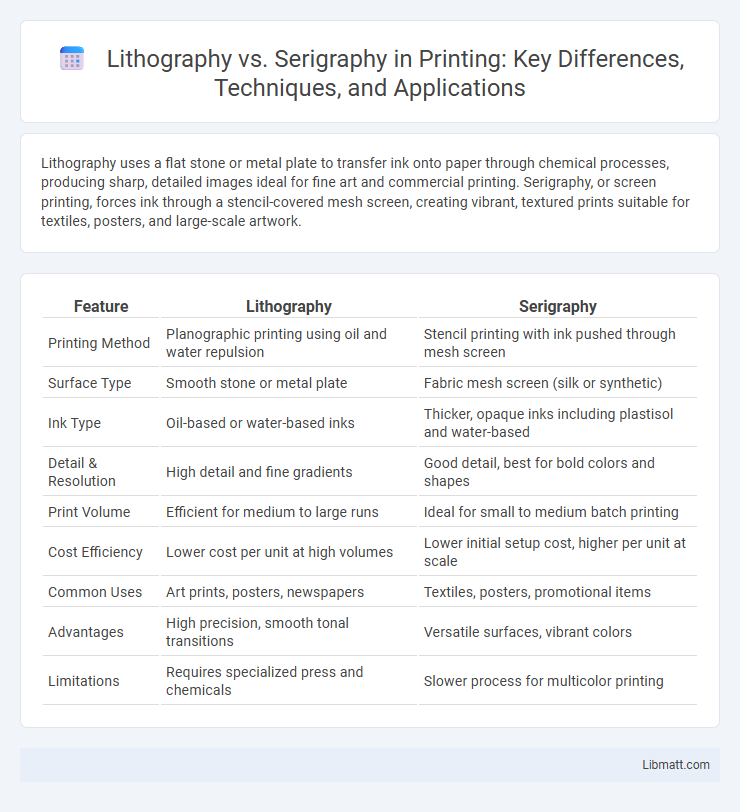Lithography uses a flat stone or metal plate to transfer ink onto paper through chemical processes, producing sharp, detailed images ideal for fine art and commercial printing. Serigraphy, or screen printing, forces ink through a stencil-covered mesh screen, creating vibrant, textured prints suitable for textiles, posters, and large-scale artwork.
Table of Comparison
| Feature | Lithography | Serigraphy |
|---|---|---|
| Printing Method | Planographic printing using oil and water repulsion | Stencil printing with ink pushed through mesh screen |
| Surface Type | Smooth stone or metal plate | Fabric mesh screen (silk or synthetic) |
| Ink Type | Oil-based or water-based inks | Thicker, opaque inks including plastisol and water-based |
| Detail & Resolution | High detail and fine gradients | Good detail, best for bold colors and shapes |
| Print Volume | Efficient for medium to large runs | Ideal for small to medium batch printing |
| Cost Efficiency | Lower cost per unit at high volumes | Lower initial setup cost, higher per unit at scale |
| Common Uses | Art prints, posters, newspapers | Textiles, posters, promotional items |
| Advantages | High precision, smooth tonal transitions | Versatile surfaces, vibrant colors |
| Limitations | Requires specialized press and chemicals | Slower process for multicolor printing |
Introduction to Lithography and Serigraphy
Lithography is a printmaking technique that uses a stone or metal plate treated to repel ink except where it is drawn, relying on the immiscibility of oil and water to create images. Serigraphy, also known as screen printing, involves forcing ink through a mesh screen stencil onto a substrate, producing sharp, vivid prints. Both methods offer unique artistic effects and are widely used in fine art, commercial printing, and textile design.
Historical Background and Development
Lithography, developed in the late 18th century by Alois Senefelder, revolutionized printing by using a grease-based image on limestone to produce multiple copies with high detail. Serigraphy, or screen printing, emerged in the early 20th century and evolved from traditional stencil techniques, gaining popularity for its versatility in printing on various surfaces and vibrant color potential. Your understanding of these methods benefits from recognizing lithography's chemical process foundation and serigraphy's adaptability in modern art and commercial use.
Core Principles and Processes
Lithography relies on the immiscibility of oil and water, using a flat stone or metal plate where images are drawn with a grease-based medium, then chemically treated to attract ink only to the drawn areas. Serigraphy, or screen printing, employs a stencil and a fine mesh screen to push ink through open areas onto a substrate, allowing for the creation of vibrant, layered prints. Both processes differ fundamentally: lithography depends on chemical repulsion and flat surfaces, while serigraphy uses physical stenciling and mesh screens for image transfer.
Materials and Equipment Used
Lithography primarily uses a flat stone or metal plate treated to repel ink in non-printing areas, alongside specialized greasy crayons or inks and a press that applies uniform pressure. Serigraphy, or screen printing, employs a fine mesh screen made of silk or synthetic fibers, stencil materials to block out areas, and a squeegee to push ink through the mesh onto the substrate. Your choice between these methods hinges on the materials compatibility and the precision of equipment that suits your project's scale and detail requirements.
Artistic Styles and Applications
Lithography offers precise, detailed imagery ideal for fine art prints, posters, and detailed illustrations, making it popular among artists seeking subtle tonal variations and smooth gradients. Serigraphy, or screen printing, excels in bold, vibrant colors with sharp edges, commonly used for graphic designs, textiles, and limited-edition prints that emphasize striking, high-contrast visuals. Your choice between these techniques depends on whether you prioritize intricate detail and texture or vivid color intensity and graphic impact.
Pros and Cons of Lithography
Lithography offers high precision and fine detail, making it ideal for producing artworks with smooth gradations and intricate designs. However, it requires specialized equipment, is labor-intensive, and can be costly due to the complexity of stone or metal plate preparation. While lithographs provide rich textures and vibrant colors, their production process limits rapid mass reproduction compared to techniques like serigraphy.
Pros and Cons of Serigraphy
Serigraphy offers vibrant color reproduction and durability, making it ideal for limited edition prints and bold graphic designs. It allows for precise layering of inks, producing rich textures and great opacity on various substrates like fabric and paper. However, serigraphy can be time-consuming and costly due to stencil preparation and setup, limiting its efficiency for large-scale or highly detailed images compared to lithography.
Key Differences Between Lithography and Serigraphy
Lithography relies on a chemical process where oil and water repel each other to transfer ink from a flat stone or metal plate, resulting in highly detailed and precise prints. Serigraphy, also known as screen printing, uses a mesh screen to push ink through stencils onto a surface, making it ideal for vibrant colors and bold designs on various materials. Your choice between lithography and serigraphy depends on the desired print detail, color intensity, and the type of medium used.
Choosing the Right Technique for Your Project
Choosing the right technique depends on your project's complexity and desired finish. Lithography excels in detailed, high-volume reproductions with smooth gradients, while serigraphy offers vibrant colors and durability for bold, graphic designs on various surfaces. Assess your budget, material, and longevity requirements to determine the best fit for your artwork.
Future Trends in Printmaking Techniques
Future Trends in printmaking techniques highlight a growing integration of digital technologies with traditional lithography and serigraphy methods. Lithography is evolving through advanced photo-chemical processes enabling higher resolution and faster production, while serigraphy embraces automation and eco-friendly inks to enhance sustainability. Innovations such as hybrid printing systems and AI-assisted design tools are set to redefine artistic expression and commercial applications in both mediums.
lithography vs serigraphy Infographic

 libmatt.com
libmatt.com